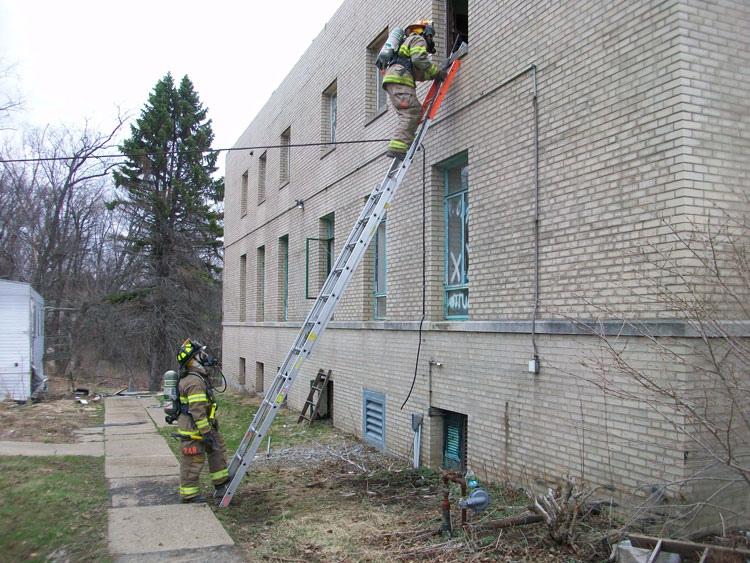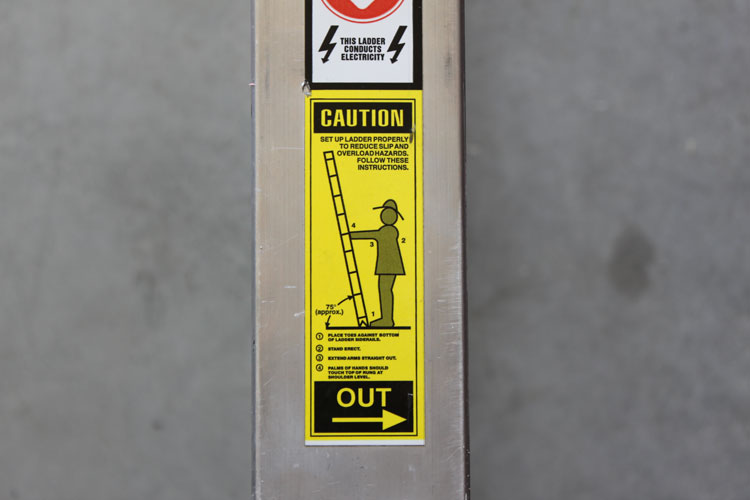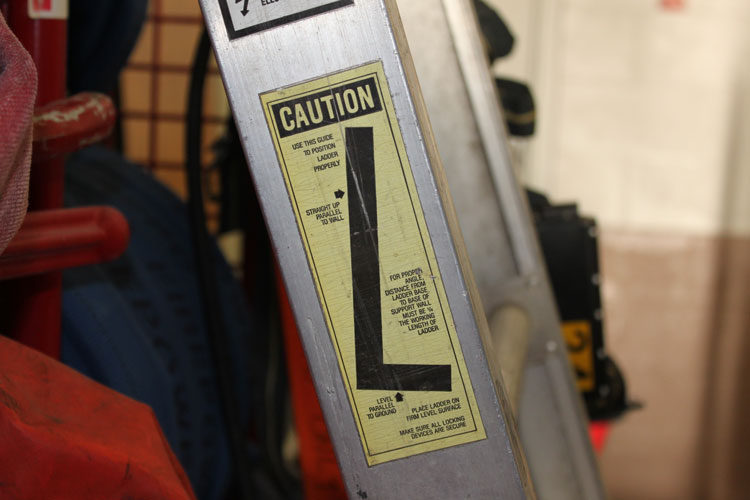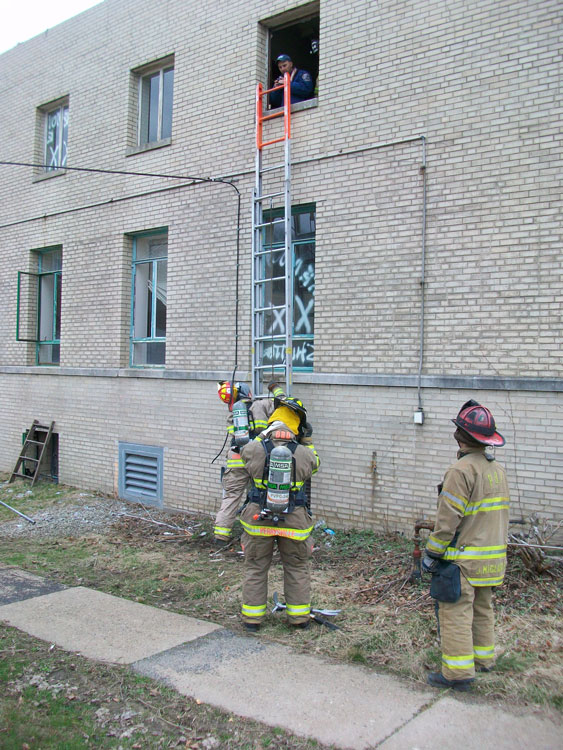
By Mark van der Feyst
Photos by author except where indicated
A big part of truck company operations is ground ladders, which are an important aspect of the fireground. As mentioned in a previous article, we should be training and practicing the raising and placing of a ground ladder with just one person. Due to staffing constraints, we cannot always dedicate two people to raising a 24-foot ground ladder. Ideally, a single firefighter can be very effective in laddering a residential structure. Part of our raise operation includes setting the ladder up at the correct climbing angle.
Our ideal climbing angle for any ladder is 75 degrees or ¼ of the ladder working height. While we instruct our newest firefighters on the correct way to set the climbing angle, it is not always ideal in reality because we are required to raise a ground ladder quickly for certain operations, and taking the time to ensure a correct climbing angle is not always a wise choice.
RELATED: Truck Company Operations: Boston’s Ladder Culture | Drills You Won’t Find in the Books: Bangor Ladder Rescue for H-Shaped Buildings | Drill: Butting Ladders | Firefighter Training Drill: Extending Ladders?
Whenever we are at a structural fire, we should be laddering all sides of the building, else at a minimum two sides. This provides the interior crews with at least two exit points out. It also provides a quick ingress point for the rapid intervention team. We also ladder structures for victim rescue. When we have fire victims hanging out in a window, ready to jump or yelling at us for help, we need to quickly raise and position the ladder to rescue them. Checking the correct climbing angle during such a situation is not necessarily viable.

(1) Ground ladder label indicating the correct way to ensure a 75-degree climbing angle.
On each ground ladder, you will find labels that will indicate safety messages, correct usage of the ground ladder, warning signs, heat labels, etc. In photo 1, we see an example of one such label. This label is showing us the correct method for setting the climbing angle once the ladder has been raised. You will find this label on the side beam of the ground ladder on both sides. This label is showing our stick man figure measuring the ladder to ensure that perfect 75-degree angle. They even have listed a four-step process;
1. Place toes at bottom of ladders side rails
2. Stand erect
3. Extend arms straight out
4. Palms of hands should touch top of rungs at shoulder level
This four-step process is what we instruct our members on when trying to determine if we have the correct climbing angle. Obviously, taking the time to follow the four-step process while a victim is hanging out the window ready to jump is not a wise decision. If we are trying to ladder a building in a non-emergency situation, then taking the time to ensure a good climbing angle will be wise.

(2) Some ladders have an “L” diagram indicating the correct angle.
Another type of label that we sometimes find on the side of the ground ladder is seen in photo 2. Some ground ladders will have a black “L” diagram on the side indicating when you will have the proper climbing angle. When you put the ladder against the support wall vertically, the “L” is crooked, pointing downward toward the ground. When you pull the ladder out from the support wall, the “L” will straighten out just as you would write it on a piece of paper. When you have the bottom part of the “L” parallel with the ground, you will have the correct climbing angle. This type of label is a quick reference guide and can be useful when trying to place a ground ladder. At night time, however, how well can you see this “L”?
When firefighters ladder a building in an emergency, we cannot take the time to measure the climbing angle. Our ground ladders are very strong and, as we pointed out in the September 2009 article, they are tested to ensure maximum working conditions. If we place a ground ladder against a building and it set at an angle that is less than 75 degrees, will this hinder our climbing operations? No, it will not.
If we have our ground ladders set at an angle that is more than 75 degrees, then we are creating trouble. A ladder that is set at 80 degrees is very intrusive when trying to climb for entry or when rescuing a person from the building. A ladder that is set at a 50-degree angle or less can be dangerous. The butt spurs of the ladder can kick out (depending upon the surface material of the ground) when we step onto it, especially if it set on a concrete surface. In such cases, the ladder is almost horizontal to the ground.

(3)
If we look at photo 3, you will see a ground ladder placed against a building. This was at a training exercise where individuals were practicing vent-enter-search techniques. The ground ladder was raised and set without checking for a proper climbing angle. The idea was to move quickly because we need to search and remove a victim from that room on the third floor. Notice that the ladder tip is not exactly at the bottom of the window sill; it is about six inches to short, and the base of the ladder is not at the edge of the concrete walkway.

(4)
Is this ladder at a 75-degree angle? Probably not, but it is at angle that will allow us to climb up, gain entry, and remove the victim down the ladder without hindering our efforts. It is at an angle that less the 75 degrees. In photo 4, we have another evolution taking place with another crew. Notice the ladder tip is right below the window sill and the base is at the edge of the concrete walkway. We have five rungs extended beyond the bed section of the ladder compared to only four rungs extend in photo 3. Again, this angle will work for the needed operation; it is not set at 75 degrees, but is less.
RELATED: Training Days: The Head-First Ladder Slide | Throw Back to Basics: Bailout
Another good reason for having a ground ladder set against a building that is less than 75 degrees is for firefighter survival. If interior crews need to bail out of the building, then having a ground ladder that is set and placed at an angle that is less than 75 degrees will offer a less intrusive angle for a head-first ladder bail.

(5) The tip is extended beyond the window sill by one rung and then the base is pulled away from the building, giving you a good climbing angle. Photo by Eric Wissner.
A quick way to determine a good climbing angle is, when we have our ground ladder vertically against the wall of the building, to raise the fly section so that the tip of the ladder extends beyond the window sill by one rung (photo 5.) At this point we can now pull the base of the ladder out from the building and stop when the tip of the ladder drops below our window sill. What is happening here is that our ladder tip drops one foot for every four feet we pull the base out from the wall, ¼ of our ladder working height.
This will only work well when we train and practice on varying windows within our response districts. Do not dwell upon setting the climbing angle to be exactly 75 degrees; make sure that it is set a good angle that will allow you to climb and conduct your assigned operation.
Mark van der Feyst has been in the fire service since 1999 and is a full-time firefighter in Ontario, Canada. He is an international instructor teaching in Canada, the United States, and India, and at FDIC. He is a local level suppression instructor for the Pennsylvania State Fire Academy and an instructor for the Justice Institute of British Columbia. He is also the lead author of Residential Fire Rescue (Pennwell).
MORE MARK VAN DER FEYST
 Mark van der Feyst has been in the fire service since 1999 and is a full-time firefighter in Ontario, Canada. He is an international instructor teaching in Canada, the United States, and India, and at FDIC. He is a local level suppression instructor for the Pennsylvania State Fire Academy and an instructor for the Justice Institute of British Columbia. He is also the lead author of Residential Fire Rescue (Pennwell).
Mark van der Feyst has been in the fire service since 1999 and is a full-time firefighter in Ontario, Canada. He is an international instructor teaching in Canada, the United States, and India, and at FDIC. He is a local level suppression instructor for the Pennsylvania State Fire Academy and an instructor for the Justice Institute of British Columbia. He is also the lead author of Residential Fire Rescue (Pennwell).
